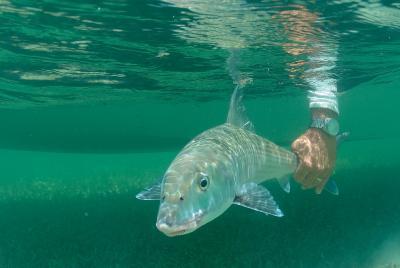|

|
 |
|
Last Updated: Feb 6, 2017 - 2:32:04 PM |

(Credit: J. Luo - UM/RSMAS)
|
Bonefish, sometimes called the gray ghost, are among the most elusive and highly prized quarry of recreational anglers in the Florida Keys, the Bahamas and similar tropical habitats around the world. Now a research team including fish ecologist Andy Danylchuk of the University of Massachusetts Amherst has documented rarely seen pre-spawning behavior in bonefish, which should aid future conservation efforts.
Habitat degradation and overfishing by uncontrolled netting threaten the bonefish, yet recreational fishing for this group of fishes is worth hundreds of millions of dollars annually, say scientists. Danylchuk and Aaron Adams, director of operations for Bonefish & Tarpon Trust (BTT) at the Florida Institute of Technology (FIT) where Adams is also an assistant research professor, are scrambling to identify and protect critical habitats and identify other ways to conserve the fishery.
With others, Adams and Danylchuk recently tracked a school of more than 10,000 bonefish as they completed the final stages of spawning migrations in the Bahamas. This week Adams shared results with the Bahamas Ministry of the Environment and conservation collaborators Bahamas National Trust and The Nature Conservancy.
Using special tracking tags they had inserted earlier into individual bonefish, the researchers report that starting in mid-afternoon, the school swirls like a tornado in water 30 feet deep. Normally found on the sea bottom in shallow waters, at this stage some of the school rush up and porpoise, gulping air as they break the surface. Bumping against each other in this pre-spawning behavior, they must avoid sharks, barracuda and Cubera snappers stalking them.
As night falls, the fish quicken their pace and head for the dropoff at the reef edge, where water depth quickly exceeds 1,000 feet. The team tracked the bonefish as they descended past 160 feet and drifting about one-quarter mile from the drop-off. Now suspended in water thousands of feet deep, these usually shallow-water swimmers spend about an hour before suddenly rushing upward to release their eggs and sperm. At that point the spawn is over and the fish quickly move back into shallower water.
By the next morning, these fish are headed home, Adams points out. They leave behind millions of fertilized, drifting eggs and begin a two-month larval stage that scientists hope will result in a new baby bonefish settlement somewhere nearby to begin the cycle over again.
It was a 2011 study published by UMass Amherst's Danylchuk, an expert on coastal fish stocks, angling impact and how to protect ecosystems,that first reported on 30 sonically-tagged bonefish observed over two years as they moved into deep water to spawn at night off Eleuthera in the Bahamas. But more details were needed about such behavior as gulping air and bumping each other, he says. Hence this new study, which looked at more detail and provides a wealth of new information he hopes to publish soon.
In particular, Danylchuk says, the recent work highlights the critical importance of protecting bonefish spawning aggregations. "This new understanding of bonefish movement and spawning aggregations has significant implications for their conservation," he says, because it establishes that pre-spawning aggregation sites are located in transition areas between shallow coastal habitats and deep ocean waters, the very same places that humans find desirable for marinas and tourism development.
Adams adds that because bonefish typically live in small, shallow-water home ranges most of the year, conservation strategies have previously focused only there. But now researchers have determined that the fish migrate long distances to gather in large schools in identifiable spawning regions, then move offshore to very deep water. He and his co-authors say this spawning migration requires a much-expanded conservation outlook that links critical deep and shallow habitats. They hope to find funding for new future expeditions to observe and document actual spawning behavior in these "ghostly" fish.
SOURCE

© Copyright 2013 by thebahamasweekly.com
Top of Page
|
|
 |

|
